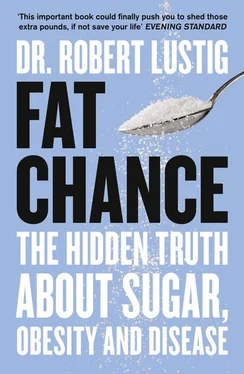Each of the stakeholders in the obesity pandemic is singing the same tune: “Your obesity is your personal responsibility, it’s your fault, and you’ve failed.” And all these accusations are a variation on a theme based on one unflappable dogma: a calorie is a calorie.
Calories Don’t Count If…
The clues are all around us as to what’s really happened. It’s time to look at where those extra calories went, because it is in these data that we will find the answer to the obesity dilemma.
There are three problems with “ a calorie is a calorie. ”
First, there is no way anyone could actually burn off the calories supplied by our current food supply. A chocolate chip cookie has the equivalent calories of twenty minutes of jogging, and working off a Big Mac would require four hours of biking. But, wait! Olympic swimmer Michael Phelps eats 12,000 calories a day and burns them off, right? If this were the case for all of us, diet and exercise should work – you’d burn more than you ate and lose weight (see chapter 13). And diet drugs should work – you take the drug, eat or absorb less, and lose the pounds. Except the meds don’t deliver on their promises. They work for a brief period, and then patients reach a plateau in weight loss (see chapter 4). [9] R. Padwal et al., “Long-Term Pharmacotherapy for Obesity and Overweight,” Cochrane Database Syst. Rev., Art. No.: CD004094. DOI: 10.1002/14651858 (2004). PMID: 15266516.
Why? Do the patients stop taking the pills? No. So why do the medications stop working? The answer: because the body is smarter than the brain is. Energy expenditure is reduced to meet the decreased energy intake. So a calorie is not really a calorie, because your caloric output is controlled by your body and is dependent on the quantity and the quality of the calories ingested.
Second, if a calorie is a calorie, then all fats would be the same because they’d each release 9.0 calories per gram of energy when burned. But they’re not all the same. There are good fats (which have valuable properties, such as being anti-inflammatory) and bad fats (which can cause heart disease and fatty liver disease; see chapter 10). Likewise, all proteins and amino acids should be the same, since they release 4.1 calories per gram of energy when burned. Except that we have high-quality protein (such as egg protein), which may reduce appetite, and we have low-quality protein (hamburger meat), which is full of branched-chain amino acids (see chapter 9), which has been associated with insulin resistance and metabolic syndrome. [10] C. B. Newgard et al., “A Branched-Chain Amino Acid-Related Metabolic Signature That Differentiates Obese and Lean Humans and Contributes to Insulin Resistance,” Cell Metab. 9 (2009): 311–26.
Finally, all carbohydrates should be the same, since they also release 4.1 calories per gram of energy when burned. But they’re not. A closer look at the specific breakdown of the carbohydrate data reveals something interesting. There are two classes of carbohydrate: starch and sugar. Starch is made up of glucose only, which is not very sweet and which every cell in the body can use for energy. Although there are several other “sugars” (glucose, galactose, maltose, and lactose), when I talk about sugar here (and in the rest of this book), I am talking about the “sweet” stuff, sucrose and high-fructose corn syrup, which both contain the molecule fructose. Fructose is very sweet and is inevitably metabolized to fat (see chapter 11). It is the primary (although not the sole) villain, the Darth Vader of the Empire, beckoning you to the dark side in this sordid tale.
The third problem with “ a calorie is a calorie ” is illustrated by the U.S. secretary of health and human services Tommy Thompson’s admonishment in 2004 that we’re “eating too damn much,” would suggest that we’re eating more of everything. But we’re not eating more of everything. We’re eating more of some things and less of others. And it is in those “some things” that we will find our answer to the obesity pandemic. The U.S. Department of Agriculture keeps track of nutrient disappearance. These data show that total consumption of protein and fat remained relatively constant as the obesity pandemic accelerated. Yet, due to the “low-fat” directives in the 1980s of the AMA, AHA, and USDA, the intake of fat declined as a percentage of total calories (from 40 percent to 30 percent). Protein intake remained relatively constant at 15 percent. But if total calories increased, yet the total consumption of fat was unchanged, that means something had to go up. Examination of the carbohydrate data provides the answer. As a percentage of total caloric intake, the intake of carbohydrates increased from 40 percent to 55 percent. [11] P. Chanmugam et al., “Did Fat Intake in the United States Really Decline Between 1989–1991 and 1994–1996?” J. Am. Diet. Assoc. 103 (2003): 867–72.
While it’s true we are eating more of both classes of carbohydrate (starch and sugar), our total starch intake has risen from just 49 to 51 percent of calories. Yet our fructose intake has increased from 8 percent to 12 percent to, in some cases (especially among children), 15 percent of total calories. So it stands to reason that what we’re eating more of is sugar, specifically fructose. Our consumption of fructose has doubled in the past thirty years and has increased sixfold in the last century. The answer to our global dilemma lies in understanding the causes and effects of this change in our diet.
There’s one lesson to conclude from these three contradictions to the current dogma. A calorie is not a calorie . Rather, perhaps the dogma should be restated thus: a calorie burned is a calorie burned, but a calorie eaten is not a calorie eaten. And therein lies the key to understanding the obesity pandemic. The quality of what we eat determines the quantity. It also determines our desire to burn it. And personal responsibility? Just another urban myth to be busted by real science.
Chapter 3
Personal Responsibility versus the Obese Six-Month-Old
Sienna is a one-year-old girl who weighs 44 pounds. She was 10 pounds at birth and was delivered by caesarean section due to her size. Her mother is not obese, but her father is overweight. Her mother tested negative for diabetes during the pregnancy. Since birth, Sienna has had an incredible appetite. Her mother could not breastfeed her because she could not keep up with the baby’s demand for food. An average infant of Sienna’s age will eat one quart of formula per day. Sienna consumed two quarts per day. When Sienna was six months old, we told her mother to start feeding her solid foods. Sienna eats constantly and will scream if her mother does not feed her. She already has high cholesterol and high blood pressure.
Is Sienna obese because of her behavior? Was this learned behavior? When would she have learned this behavior, and from whom? Has she, at age one, learned to control her mother to get what she wants? Should she accept personal responsibility for her actions?
Based on “a calorie is a calorie,” behaviors come first. Personal responsibility implies a choice: that there is a conscious decision leading to a behavior. This behavior is formed because of learned benefits or detriments (e.g., a child placing her hand on a stove and learning it is hot). But does this make sense with regard to obesity? In everyone? In anyone? There are six reasons to doubt “personal responsibility” as the cause of obesity.
1. Obesity Is Not a Choice
Читать дальше












